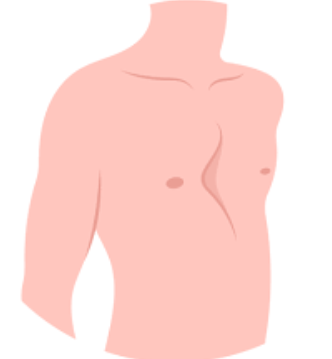Pectus excavatum, a congenital condition where the breastbone is sunken into the chest, can affect respiratory function and thoracic mobility. Exercise and rehabilitation are known to have beneficial effects in managing these symptoms. Below is an explanation of the effects of exercise on pectus excavatum.
1. Improvement in Respiratory Function
In pectus excavatum, the deformation of the chest wall can prevent the lungs from fully expanding, resulting in shallow breathing. By performing exercises that strengthen the respiratory muscles and stretch the chest wall, thoracic mobility can improve, leading to deeper breathing and better oxygen intake. In particular, diaphragmatic breathing and thoracic expansion exercises are considered effective.
2. Improved Flexibility
In pectus excavatum, the range of motion of the thoracic spine and ribs may be limited, but continued stretching and posture correction exercises can improve flexibility in the chest and shoulder areas. This leads to better overall posture and more comfortable movements in daily life.
3. Posture Improvement
Patients with pectus excavatum often develop a forward-leaning posture due to the shape of their chest. This poor posture can lead to muscle imbalances and further decline in physical function. By combining chest stretches with back muscle strengthening exercises, improvements in posture can be expected through rehabilitation.
References
Several studies support the effectiveness of exercise therapy for pectus excavatum, including:
- Haller JA, Loughlin GM. Pectus excavatum: diagnosis and treatment. Current Problems in Surgery. 2000; 37(6):401-450.
- This paper discusses not only surgical treatments for pectus excavatum but also the role of exercise therapy. The effectiveness of exercises aimed at improving chest flexibility and respiratory function is emphasized.
- Park HJ, Lee SY, Lee SJ, Lee CS. Effects of corrective exercises on posture and respiratory function in patients with pectus excavatum. Journal of Physical Therapy Science. 2014; 26(9):1401-1404.
- This study investigated the effects of corrective exercises on posture and respiratory function in patients with pectus excavatum. It reported that exercises improved chest mobility and enhanced the quality of breathing.
These references underline the effectiveness of exercise therapy as a non-surgical approach to managing pectus excavatum. If you are interested in our Physicaltharapy services , please contact us !! ( Kosaku Ota )
Adress: Physiocenter,
E-building, Tokyo Jikaei Medical university hospital,
3-19-18 , Nishi-shinbashi, Minatoku, Tokyo
HP: https://physiocenter.jp
Contact e-mail: info@physiocenter.jp ( Kosaku Ota : Schroth scoliosis therapist, Physiotherapist )




